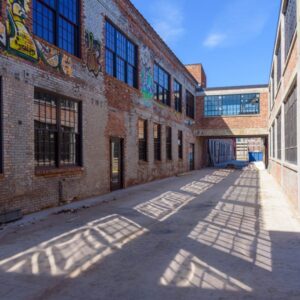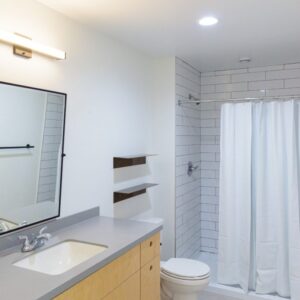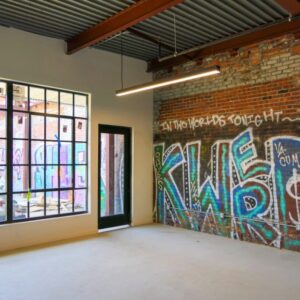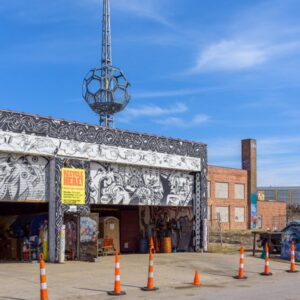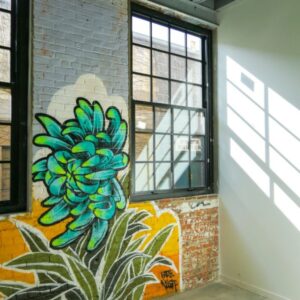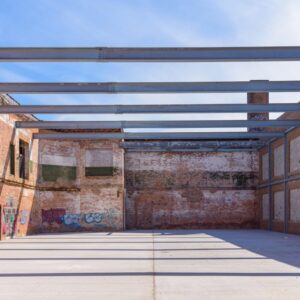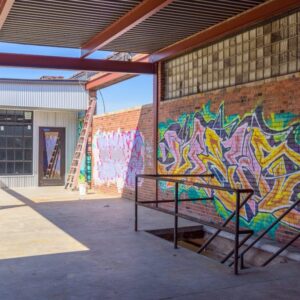In a Nutshell
What: An overview of the Dreamtroit development in Detroit, a mixed-use facility in a historic auto plant that will create affordable housing in a neighborhood with rising housing costs, enabling artists to remain in the community and continue to contribute to its cultural fabric, as well as 38,000 square feet of quality commercial space for arts and culture organizations, small businesses, and events.
Sector: Community Development, Housing, Arts and Culture
Location: Detroit, MI (Northwest Goldberg)
Size: 90,000 square feet
Cost: $30 million
Funding Sources: IFF, Capital Impact Partners, Invest Detroit, Local Initiatives Support Corporation (LISC), Detroit Housing for the Future Fund, Detroit Economic Growth Corporation, Michigan Community Capital, Michigan Community Revitalization Program, New Markets Tax Credits, Historic Tax Credits
IFF Support: $3.3 million loan closed in February 2021 (which included $810,000 for predevelopment activities and $2.49 million for construction)
Design: Kraemer Design Group (architect of record) and 1+1+ Architects (design architect)
General Contractor: MiG Construction
Impact: Creation of 76 units of make/live rental housing, 58 of which will be affordable to tenants earning less than 80 percent of the Area Median Income (AMI) and 18 of which are designed as workforce housing affordable to tenants earning less than 120 percent of the AMI
Matt Naimi and Oren Goldenberg don’t fit the profile of most real estate developers, let alone those who take on projects with complex capital stacks running into the tens of millions of dollars. An artist who runs the city’s only public recycling center and a filmmaker, respectively, Naimi and Goldenberg are far more interested in storytelling than pro formas and debt service coverage ratios. Despite that, the pair is on the verge of completing their first project – Dreamtroit – a $30 million redevelopment of a historic industrial complex that helped forge Detroit’s identity as the Motor City.
On July 1, the 90,000-square-foot Dreamtroit will open as a haven for Detroit’s arts and culture community, an anchor for economic and community development in its neighborhood, and a model for a more sustainable future in the city. To accomplish this, Dreamtroit will offer 76 units of make/live housing designed to be affordable to members of the creative community, ample indoor and outdoor makers’ spaces to support creative endeavors, a 15,000-square-foot outdoor art gallery that doubles as event space, and 38,000 square feet of space that will house Naimi’s Recycle Here!, a restaurant, bar, grocery store, and three nonprofit organizations – Teach. Empower. Achieve, Green Living Science, and Make Art Work, which has long operated a community sculpture park on the Dreamtroit campus called the Lincoln Street Art Park and collaborative community arts programming.
“A lot of people for the last 20 years have been saying, ‘What happened to Detroit? How did it fall behind?’ and I’ve always had the perspective that Detroit is what the future is going to look like for everybody if we don’t change the way society operates,” says Naimi. “What we’re creating within this neighborhood with Dreamtroit is a community that embraces and holds up its culture, while taking care of all citizens in a truly mixed-income place that welcomes people from all walks of life.”
Repurposing a piece of Detroit’s history
While Dreamtroit is a massive, trajectory-changing project for the neighborhood now known as Northwest Goldberg (among other names), it began with little more than a desire in 2017 to fix the roof of the original building on the sprawling, 3.8-acre property so that Recycle Here! and the Lincoln Street Art Park could continue to operate sustainably on the campus.
“Many art and community spaces in Detroit are falling apart because people have not been able to maintain them,” says Goldenberg. “We had a precious asset in this building, located in an amazing community, and if we couldn’t figure out how to keep it here, we weren’t sure what would keep us here.”
Longtime friends and collaborators, Naimi and Goldenberg began to explore their options and determined that repairing the roof alone could cost as much as $3 million. As the pair contemplated how to proceed, their vision for the complex expanded from doing what was needed to keep the property viable to transforming it into a one-of-a-kind hub for Detroit’s creative community that could contribute to an equitable revitalization of a neighborhood deeply affected by decades of disinvestment.
“Artists and culture creators often end up activating underutilized spaces, which in turn attracts investment, ultimately driving them out of the community as it becomes more expensive to live and work in those spaces,” explains Naimi. “We think about that like a pebble hitting a pond, with the creativity rippling away from the center. What we’re doing with Dreamtroit is putting creativity at the core so that the investment can happen around it without losing the culture that made those investments possible.”
“We had a precious asset in this building, located in an amazing community, and if we couldn’t figure out how to keep it here, we weren’t sure what would keep us here.”
By reimagining the Dreamtroit property, Naimi and Goldenberg are continuing a legacy of reinvention on the campus stretching back more than a century. Built in 1908 as a factory for the Warren Motor Car Company, one of Detroit’s earliest automobile manufacturers, the Dreamtroit complex was purchased several years later by the Lincoln Motor Company, which developed its first engine prototype in the complex. Sold again in 1922 to Henry Ford, the factory produced Model T sedans that made automobiles affordable to the masses and cemented Detroit’s status as the center of the automotive universe.
In later years, the complex housed a refrigeration company and a grocery wholesaler, with continuous modifications to the site taking place to meet the needs of the companies that inhabited it. The result was an array of contrasting building materials and architectural styles that reflect the same type of evolution that occurred over the years in the neighborhood surrounding the complex.
Like much of Detroit’s urban center, the neighborhood experienced significant change in the 1960s as once prevalent manufacturing job opportunities began to disappear, racial tension erupted into riots, and white flight to the suburbs occurred. In the decades that followed, structural disinvestment in the predominantly Black neighborhood contributed to the deterioration of the community’s infrastructure, and vacant lots became prevalent despite residents and community stakeholders who remained committed to the area.
“We see the Dreamtroit project as a mechanism for growth that brings everybody in the neighborhood along with it.”
“This neighborhood has lost 85% of its homes since its peak and is filled with abandoned buildings and vacant lots, but calling it a blank canvas for redevelopment totally misses the mark because of what’s still here,” says Naimi. “There are people who have lived here for many years, we’ve been here, and I think we can look to our past to inform the future of this neighborhood. We see the Dreamtroit project as a mechanism for growth that brings everybody in the neighborhood along with it. By working in close partnership with our neighbors, we’re all going to be moving forward together, hand in hand, step in step.”
How Dreamtroit became reality
Collaboration and a clear sense of purpose have been key to getting from Naimi and Goldenberg’s vision for a mixed-use facility designed as a community-centric bastion for arts and culture to a tangible project that realizes the first-time developers’ goals. After starting out with limited knowledge of the complex financing mechanisms that would be needed for the project, the pair learned by doing, with the help of a trusted mentor who helped guide them through the real estate development process. And while there were ample obstacles along the way, Naimi and Goldenberg adhered to a simple philosophy whenever the project reached an inflection point.
“We had a very clear goal for this project, which was to keep the recycle center open and to keep the art park free and freaky,” says Goldenberg. “As we got pulled in different directions and considered various funding strategies to make Dreamtroit happen, we always made our decisions with that goal and the community in mind.”
Profit, in particular, was far less important, making it easier for the developers to preserve their vision for Dreamtroit while assembling the funding and financing needed to bring the $30 million project to fruition. They were ultimately able to do so with the support of a diverse group of public and private entities. In addition to a $3.3 million loan from IFF – which included predevelopment financing provided in partnership with Invest Detroit – Dreamtroit was developed with financing from Capital Impact Partners, Local Initiatives Support Corporation (LISC), Detroit Housing for the Future Fund, Detroit Economic Growth Corporation, Michigan Community Capital, and the Michigan Community Revitalization Program. The project also leveraged State of Michigan New Markets Tax Credits allocated by Michigan Community Capital and Historic Tax Credits allocated by Capital Impact Partners, with US Bank and Impact Credit Partners serving as the investors for the tax credits, respectively.
After breaking ground on the project in the first quarter of 2021, MiG Construction set about bringing a plan developed by 1+1+ Architects and Kraemer Design Group to life. Since then, the property has undergone a massive transformation that included the demolition of a former warehouse to clear space on the property, extensive cleaning and debris clearing, a full façade restoration, roof replacement, and the build out of 90,000 square feet of interior space, among other improvements.
“Now that we’ve preserved the building and created a platform for residents, tenants, and the community to build on, we’re looking forward to Dreamtroit taking on its own identity as the space is filled and the arts and culture community makes it its own.”
In the main facility on the campus where the automotive factory once operated, a mix of studio, one-bedroom, two-bedroom, and co-living apartments with shared kitchens and bathrooms feature historic replica factory windows, 13-foot ceilings, exposed timber and concrete, and graffiti accumulated over the years that both preserves the industrial character of the property and highlights the creative energy harnessed on the campus.
All residents will have access to five unique gathering spaces to further stoke creative combustion, with the apartments themselves designed in a utilitarian way to double as work spaces. With the gallery and event space, and the amenities provided by the commercial tenants co-located in the complex, Dreamtroit will provide residents with everything needed to live comfortably, create their art, and sell it in one place. And, in keeping with Naimi and Goldenberg’s desire to maximize sustainability at Dreamtroit, all waste generated by residents and the complex’s commercial tenants will be routed through Recycle Here!, which will help the environment and enable the recycling center to achieve greater impact.
“If we were seasoned in development and had known what we were getting into, this project wouldn’t have happened,” says Naimi. “Not knowing allowed us to see something and find a way to make it happen without feeling limited by the standard ways of doing projects like this. Now that we’ve preserved the building and created a platform for residents, tenants, and the community to build on, we’re looking forward to Dreamtroit taking on its own identity as the space is filled and the arts and culture community makes it its own.”
Read about additional community-strengthening projects in Michigan financed by IFF
